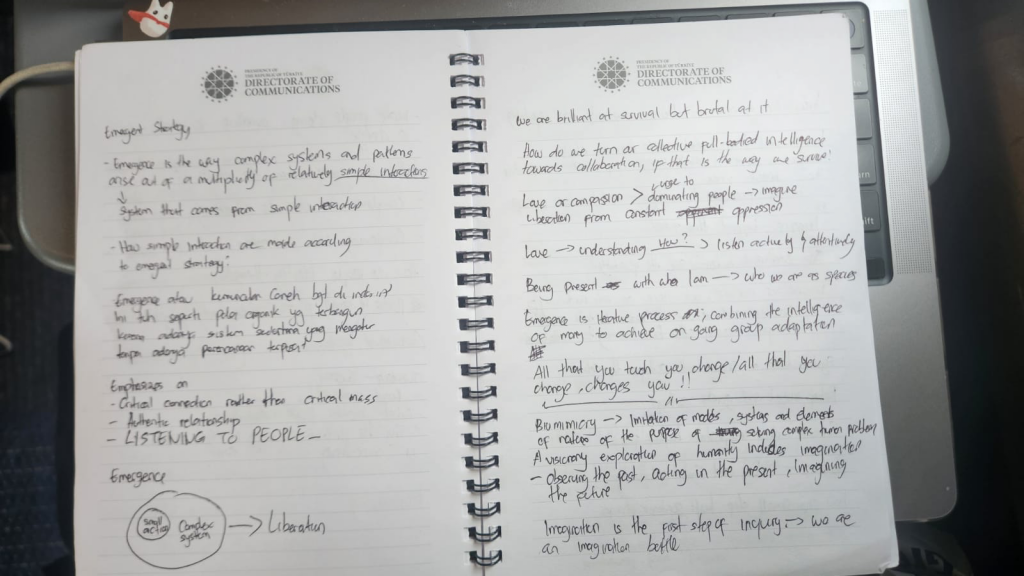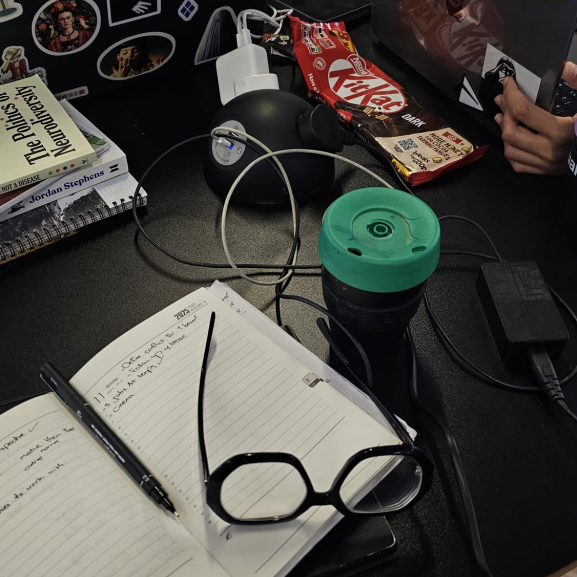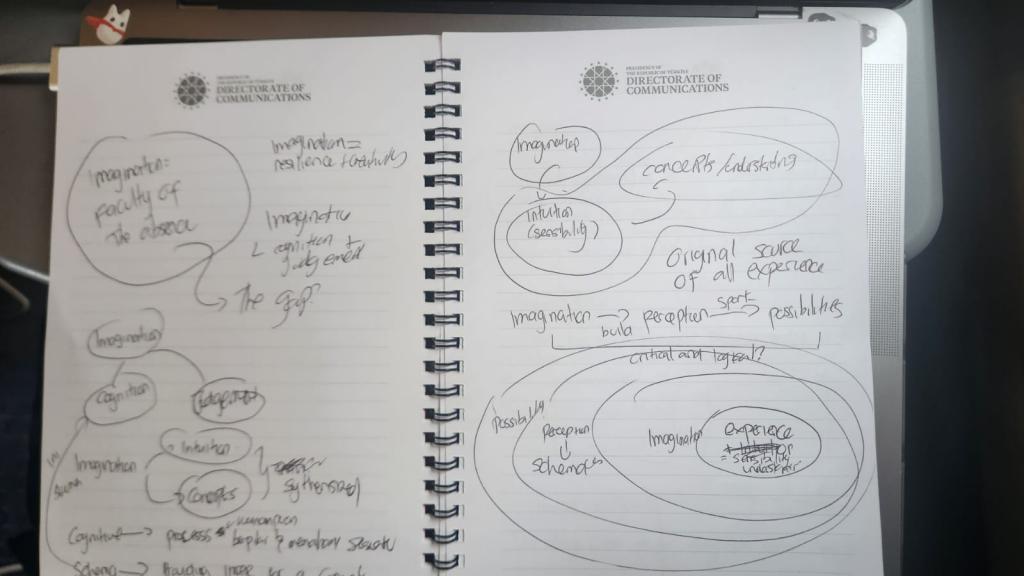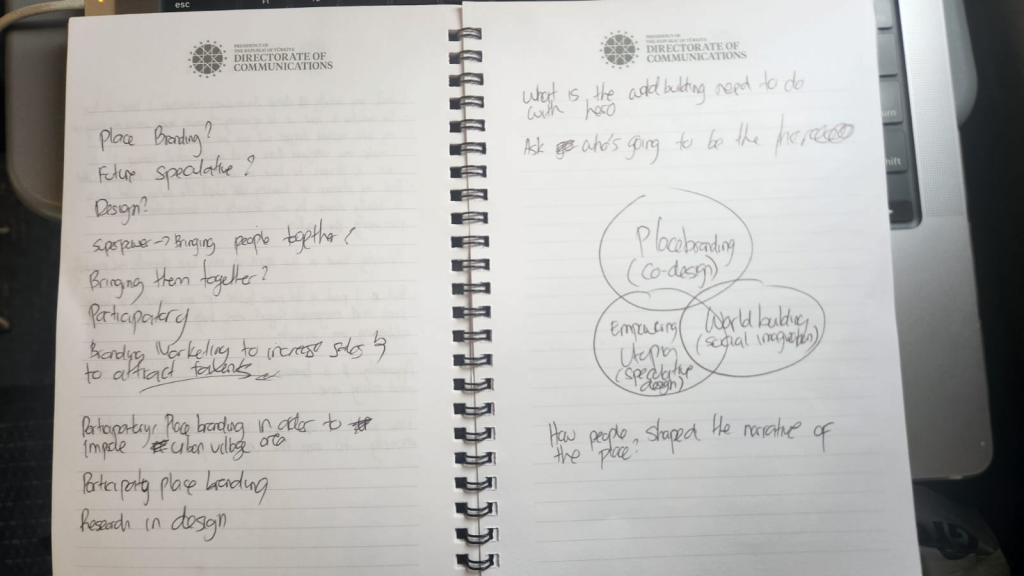Alright, I know how hard it is to explain my own project. Even to explain it as quick as 3 minutes elevator pitch. Not only to communicate it in English but also in Indonesian. Therefore, I spent my weekend to literate myself and redefining my research question after I did 3 tutorials in a row with Zuleika, Richie and Roger last week.
But now I am going to make it longer here (I HAVE TO).
Who Am I?
During an annotated bibliography session with Zuleika, I shared my frustration about how to position myself within this project. Who am I to galvanize a community to create change? Even after conducting my first intervention with the people in Cipadu last month, I still feel a significant gap between myself, the community’s overall needs, and my proposed ideas.
I asked myself several times: “what is my superpower?”
Zuleika suggested that I shall deepen my understanding of grassroots practice and connection, and recommended me to read Emergent Strategy by Adrienne Maree Brown to gain more insight into grassroots movements.
The book turned out to be deeply inspiring, expanding my perspective on enabling and mobilizing grassroots change. Brown’s work draws heavily on empirical insights and diverse research, with particular influence from Octavia Butler. Butler serves as Brown’s multifaceted inspiration for Emergent Strategy, profoundly shaping her views on change, leadership, and the role of imagination in creating a more just and liberated world.

The book revolves around Butler’s famous words: “All that you touch, you change. All that you change, changes you.” This quote drives the book’s core philosophy, planning through an emergent strategy rooted in the belief that transform yourself, transform the world.
The author focuses on how massive the wicked problems in the world, and we are just a tiny piece that makes up this world. Thus, we have to transform with our own capacity. A small ripple might create a big wave if it is constantly being moved. This also aligns with DelSasto’s idea in Design and Social Imagination (2022), that a change begins from one passionate person who has a goal in transforming the future. However, these ideas from two amazing authors did not validate my frustration on how can I step in to a neighbourhood that caught in a circle of wicked problems like Cipadu, if I only a who I am as a citizen, who works as an advertiser, design studio owner, a woman and never have I ever lead an entire community.
However, I did get snapped out of it. Twice.
Or maybe three times.
With Zuleika’s closing in our final session: “Well, you know exactly what to do, if you are an advertiser.”
Slapped.
And when I talked with Andi Qodir, a creative director of Karasa BDG who initiated Graphic Design Village in Gempolsari, Bandung, West Java. He said, some changes come from within. That is why he was able to create a new community within the society using his own superpower: graphic design.

I will elaborate more on my interview with Kang Kodir on the next blog report.
And lastly, is when I have group learning discussion at the CSM with my girls; Meaghan and Goldaneh.

After I showed them my research, they told me I was almost forgotten to give agency and authority about my project. When I might already know who am I and what am I capable of. I was too focused on searching my superpower, when it is already there–facilitating people to share their story.
Therefore, I am Sasha, a creative strategist who have been working as a strategist and advertiser for almost 5 years, an Indonesian, an Asian, a Muslim, a sci-fi fan, and currently interested in design for social innovation. And I know I can help people communicating their story, and enhance them with a tailored storytelling.
Who Am I Talking To?
But who is this project for?
When I explain my recent findings and my presentation to both Richie and Roger, I got an input to give more context towards my communication so that I can communicate it with my targeted audience effectively and efficiently.
Roger specifically gave his direct feedback on my presentation, which are:
- You should carefully consider the context and audience for each piece of communication you create. Especially, the relationship between visuals and text when you’re speaking or presenting. This often means creating two or three different versions of your PowerPoint, depending on the situation and who you’re presenting to. (Don’t forget to keep your original version as part of your research documentation.)
- For your written report, the audience may be less varied, but it’s still important to pay attention to the tone, formality, and voice of your writing based on who is likely to read it.
- As for your Learning Log or Blog, you may not have a clearly defined audience, but it’s important to remain authentic—while still aligning with the academic or professional fields you’re engaging with.
So from all of these feedbacks, it is clearly I have to put myself on different positioning when I talk with different stakeholders within my database. Thus, I try to map out my stakeholder radar into this image:

Most of the core target audience are apparently falls into grassroot to marginalized community. As subsequence to this, I need to make the presentation that can deliver a residual communication, based on what Richie said, so it will a meaningful impact for the people at the core and the ring 1 of my stakeholder.

Moreover, this is the latest picture of the neighbourhood on 14 August 2025. The huge rain was pouring excessively until it flooded the entire neighbourhood. Pak Ade, the village leader, told me the flood height is up until an adult’s belly length. This tragedy torn my heart apart, because apparently the flood came from its nearby area that has higher sea level than the area in Cipadu.
Their situation, location and condition are highly vulnerable. I realized that having a serious conversation at this point of time might not be really helpful for them. I believe it will be better if I can facilitate a co-design discussion that could spark an imaginative yet casual approach for them.
As Imaginative as Possible
And as critical as possible.
Because when I am spiralling, Richie told me that “sometimes the gap is found in your critical thinking”. It is also important to give your ideas a perspective, so I will found the most important matters when I am being critical over it.
Then instead of thinking of what this project could be in the future, I landed myself in the present time to think what I can do NOW!
So I read,
I write,
I read
and I map out.

If imagination does not come naturally, because it requires sensibility and understanding to enhanced imagining experience, which later can stimulate idea of possibilities (DelSesto, 2022). But how would I be able to facilitate people to nurture their radical ideas to improvise the way they live in the neighborhood?
Well, not until Goldaneh’s notification popped out on my phone.

She sent me the article about worldbuilding that might be relevant to my project. The article already hooked my attention with its abstract begins with “We will look at Worldbuilding as a methodology, as a tool able to define our future, a tool where the only limit is the one, we fix, a tool able to scale” (Grenier, 2022) which is fascinating because I thought that worldbuilding is for gaming. But then I realized, this is related to what Richie told me about scenario based experience, and my initial idea on making an Imaginarium for social innovation.
Thus, I probably will be able to develop a “Future Neighbourhood” based on speculated future from social realities, to spark hope in people.

AND I finally come up with an idea for my next intervention. Co-design the world that people want based on multimodality experience using zine-making. Zine-making is a universal medium for people to make art, and everyone is welcome! I am trying to take an action on this with Indonesian Collective in London called ‘London Bergerak’ to initiate an event as shown below:

For further information, check out the Instagram post: https://www.instagram.com/p/DNQRAZUslwn/?img_index=1
SO YEAAH
Let’s see whether an Imaginarium based on worldbuilding and design for social innovation does really work as an emergent to make people contribute in building their vulnerable neighbourhood.
The event will be held on August 16th 2025! See ya lateer~
Bibliography:
DelSesto, M. (2022) Design and the social imagination. London ; New York: Bloomsbury Visual Arts (Designing in Dark Times).
Brown, A.M. (2017) Emergent strategy: shaping change, changing worlds. Chico: AK Press.
Grenier, A. (2022) ‘Worldbuilding as a translation and manifestation of future realities’.
Leave a Reply